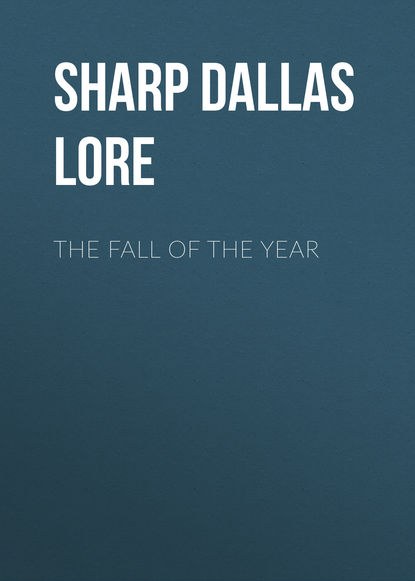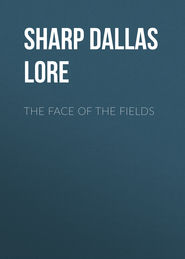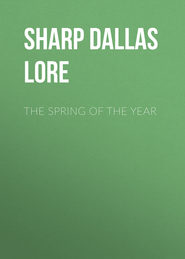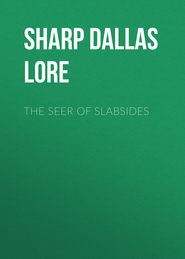По всем вопросам обращайтесь на: info@litportal.ru
(©) 2003-2024.
✖
The Fall of the Year
Настройки чтения
Размер шрифта
Высота строк
Поля
They continue to wiggle in this fashion for some weeks, until the yolk of the egg is absorbed, and they have grown to be nearly half an inch long. They are then free from the rock and swim off, looking as much like their parents as children can, and every bit as ugly.
Ugly? Did I say ugly? Is a baby ever ugly to its mother? Or a baby toadfish to its father? No. You cannot love a baby and at the same time see it ugly. You cannot love the out of doors with all your mind as well as with all your heart, and ever see it ugly.
All this time the father has been guarding the little toadfish; and if, during the whole period, he goes out to get a meal, I have not been able to find when it is, for I always find him at home, minding the babies.
The toadfish lives entirely unmolested by enemies, so far as I can learn; and his appearance easily explains the reason of it. I know of nothing that would willingly enter a croaking, snapping, slimy toadfish’s nest to eat him; and it takes some courage to put one’s hand into his dark hole and pull him out.
His principal diet seems to be shrimp, worms and all kinds of small fish. Yet he may be said to have no principal diet; for, no matter what you are fishing for, or what kind of bait you are using, if there is a toadfish in the vicinity you are sure to catch him. If fishing along a wharf in September, you may catch the fish, and an old shoe along with him – with her, perhaps I should say.
And if you do, please notice how wise and thoughtful the face, how beautifully marbled the skin, how courageous the big strong jaw!
Ugly? Not if you will put yourself in the toadfish’s shoe.
CHAPTER IV
A CHAPTER OF THINGS TO SEE THIS FALL
I
YOU ought to see the sky – every day. You ought to see, as often as possible, the breaking of dawn, the sunset, the moonrise, and the stars. Go up to your roof, if you live in the city, or out into the middle of the Park, or take a street-car ride into the edge of the country – just to see the moon come up over the woods or over a rounded hill against the sky.
II
You ought to see the light of the October moon, as it falls through a roof of leafless limbs in some silent piece of woods. You have seen the woods by daylight; you have seen the moon from many places; but to be in the middle of the moonlit woods after the silence of the October frost has fallen is to have one of the most beautiful experiences possible out of doors.
III
You ought to see a wooded hillside in the glorious colors of the fall – the glowing hickories, the deep flaming oaks, the cool, dark pines, the blazing gums and sumacs! Take some single, particular woodland scene and look at it until you can see it in memory forever.
IV
You ought to see the spiders in their airships, sailing over the autumn meadows. Take an Indian Summer day, lazy, hazy, sunny, and lie down on your back in some small meadow where woods or old rail fences hedge it around. Lie so that you do not face the sun. The sleepy air is heavy with balm and barely moves. Soon shimmering, billowing, through the light, a silky skein of cobweb will come floating over. Look sharply, and you will see the little aëronaut swinging in his basket at the bottom of the balloon, sailing, sailing —
Away in the air air —
Far are the shores of Anywhere,
Over the woods and the heather.
V
You ought to see (only see, mind you,) on one of these autumn nights, when you have not on your party clothes – you ought to see a “wood pussy.” A wood pussy is not a house pussy; a wood pussy is a wood pussy; that is to say, a wood pussy is a —skunk! Yes, you ought to see a skunk walking calmly along a moonlit path and not caring a fig for you. You will perhaps never meet a wild buffalo or a grizzly bear or a jaguar in the woods nearest your house; but you may meet a wild skunk there, and have the biggest adventure of your life. Yes, you ought to see a skunk some night, just for the thrill of meeting a wild creature that won’t get out of your way.
VI
You ought to see the witch-hazel bush in blossom late in November. It is the only bush or tree in the woods that is in full bloom after the first snow may have fallen. Many persons who live within a few minutes’ walk of the woods where it grows have never seen it. But then, many persons who live with the sky right over their heads, with the dawn breaking right into their bedroom windows, have never seen the sky or the dawn to think about them, and wonder at them! There are many persons who have never seen anything at all that is worth seeing. The witch-hazel bush, all yellow with its strange blossoms in November, is worth seeing, worth taking a great deal of trouble to see.
There is a little flower in southern New Jersey called pyxie, or flowering moss, a very rare and hidden little thing; and I know an old botanist who traveled five hundred miles just to have the joy of seeing that little flower growing in the sandy swamp along Silver Run. If you have never seen the witch-hazel in bloom, it will pay you to travel five hundred and five miles to see it. But you won’t need to go so far, – unless you live beyond the prairies, – for the witch-hazel grows from Nova Scotia to Florida and west to Minnesota and Alabama.
There is one flower that, according to Mr. John Muir (and he surely knows!), it will pay one to travel away up into the highest Sierra to see. It is the fragrant Washington lily, “the finest of all the Sierra lilies,” he says. “Its bulbs are buried in shaggy chaparral tangles, I suppose for safety from pawing bears; and its magnificent panicles sway and rock over the top of the rough snow-pressed bushes, while big, bold, blunt-nosed bees drone and mumble in its polleny bells. A lovely flower worth going hungry and footsore endless miles to see. The whole world seems richer now that I have found this plant in so noble a landscape.”
And so it seemed to the old botanist who came five hundred miles to find the tiny pyxie in the sandy swamps of southern New Jersey. So it will seem to you – the whole world will not only seem richer, but will be richer for you – when you have found the witch-hazel bush all covered with summer’s gold in the bleak woods of November.
VII
You ought to see a big pile of golden pumpkins in some farmhouse shed or beside the great barn door. You ought to see a field of corn in the shock; hay in a barn mow; the jars of fruit, the potatoes, apples, and great chunks of wood in the farmhouse cellar. You ought to see how a farmer gets ready for the winter – the comfort, the plenty, the sufficiency of it all!
VIII
You ought to see how the muskrats, too, get ready for the winter, and the bees and the flowers and the trees and the frogs – everything. Winter is coming. The cold will kill – if it has a chance. But see how it has no chance. How is it that the bees will buzz, the flowers open, the birds sing, the frogs croak again next spring as if there had been no freezing, killing weather? Go out and see why for yourselves.
IX
You ought to see the tiny seed “birds” from the gray birches, scattering on the autumn winds; the thistledown, too; and a dozen other of the winged, and plumed, and ballooned, seeds that sail on the wings of the winds. You should see the burdock burs in the cows’ tails when they come home from the pasture, and the stick-tights and beggar-needles in your own coat-tails when you come home from the pastures. And seeing that, you should think– for that is what real seeing means. Think what? Why, that you are just as good as a cow’s tail to scatter Nature’s seeds for her, and not a bit better, as she sees you.
X
You ought to see the migrating birds as they begin to flock on the telegraph wires, in the chimneys, and among the reeds of the river. You ought to see the swallows, blackbirds, robins, and bluebirds, as they flock together for the long southern flight. There are days in late September and in early October when the very air seems to be half of birds, especially toward nightfall, if the sun sets full and clear: birds going over; birds diving and darting about you; birds along the rails and ridge-poles; birds in the grass under your feet – birds everywhere. You should be out among them where you can see them. And especially you should see – without fail, this autumn and every autumn – the wedge of wild geese cleaving the dull gray sky in their thrilling journey down from the far-off frozen North.
CHAPTER V
WHIPPED BY EAGLES
AS you head into Maurice River Cove from Delaware Bay by boat, the great eagle’s nest of Garren’s Neck Swamp soon looms into view. It is a famous nest, and an ancient nest; for it has a place in the chart of every boat that sails up the river, and has had for I don’t know how many years. From the river side of the long swamp the nest is in sight the year round, but from the land side, and from the house where we lived, the nest could be seen only after the leaves of the swamp had fallen. Then all winter long we could see it towering over the swamp; and often, in the distance, we could see the eagles coming and going or soaring in mighty circles high up in the air above it.
That nest had a strange attraction for me. It was the home of eagles, the monarchs of this wide land of swamp and marsh and river.
Between me and the great nest lay a gloomy gum swamp, wet and wild, untouched by the axe and untraveled, except in winter by the coon-hunters. The swamp began just across the road that ran in front of the house; and often at night I would hear the scream of a wild cat in the dark hollows; and once I heard the pat, pat of its feet as it went leaping along the road.
Then beyond the swamp and the nest stretched a vast wild marsh-land, where the reeds grew, and the tides came in, and the mud-hens lived. And beyond that flowed the river, and beyond the river lay another marsh, and beyond the marsh another swamp. And over all this vast wild world towered the nest of the eagles, like some ancient castle; and over it all – swamp and marsh and river – ruled the eagles, as bold and free as the mighty barons of old.
Is it any wonder that I often found myself gazing away at that nest on the horizon and longing for wings? – for wings with which to soar above the swamp and the bay and the marsh and the river, to circle about and about that lofty eyrie, as wild as the eagles and as free? Is it any wonder that I determined some day to stand up in that nest, wings or no wings, while the eagles should scream about me, and away below me should stretch river and marsh and swamp?
To stand up in that nest, to yell and wave my arms with the eagles wheeling and screaming over me, became the very peak of my boy ambitions.
And I did it. I actually had the eggs of those eagles in my hands. I got into the nest; but I am glad even now that I got out of the nest and reached the ground.
It must have been in the spring of my fourteenth year when, at last, I found myself beneath the eagle tree. It was a stark old white oak, almost limbless, and standing out alone on the marsh some distance from the swamp. The eagle’s nest capped its very top.
The nest, I knew, must be big; but not until I had climbed up close under it did I realize that it was the size of a small haystack. There was certainly half a cord of wood in it. I think that it must originally have been built by fish hawks.
Holding to the forking top upon which the nest was placed, I reached out, but could not touch the edge from any side.
I had come determined to get up into it, however, at any hazard; and so I set to work. I never thought of how I was to get down; nor had I dreamed, either, of fearing the eagles. A bald eagle is a bully. I would as soon have thought of fearing our hissing old gander at home.
As I could not get out to the edge of the nest and scale the walls, the only possible way up, apparently, was through the nest. The sticks here in the bottom were old and quite rotten. Digging was easy, and I soon had a good beginning.
The structure was somewhat cone-shaped, the smaller end down. It had grown in circumference as it grew in years and in height, probably because at the bottom the building materials had decayed and gradually fallen away, until now there was a decided outward slant from bottom to top. It had grown lopsided, too, there being a big bulge on one side of the nest near the middle.
The smallness of the bottom at first helped me; there was less of the stuff to be pulled out. I easily broke away the dead timbers and pushed aside the tougher sticks. I intended to cut a channel clear to the top and go up through the nest. Already my head and shoulders were well into it.











